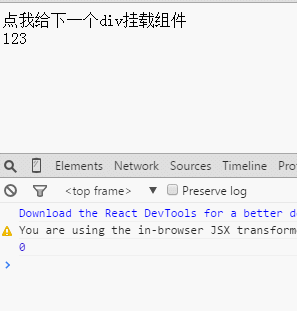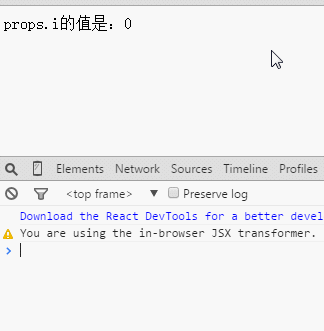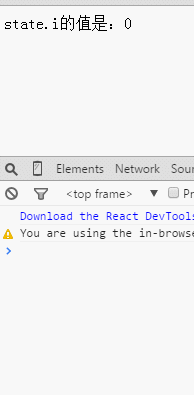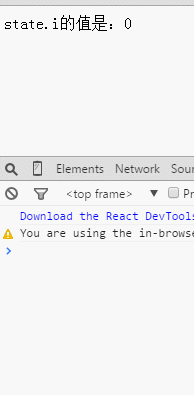React入门--------组件的生命周期
- Mounting/组件挂载相关:
componentWillMount
componentDidMount
- Updating/组件更新相关:
componentWillReceiveProps
shouldComponentUpdate
componentWillUpdate
componentDidUpdate
- Unmounting/组件移除相关:
componentWillUnmount
一、Mounting/组件挂载相关
componentWillMount
在组件挂载之前执行,但仅执行一次,即使多次重复渲染改组件,或者改变了组件的state。若希望该回到能执行多次,可以使用ReactDOM.unmountComponentAtNode移除掉已有的组件,然后再重新render。
var diva = document.getElementById('a');
var divb = document.getElementById('b');
var i=;
var Component1 = React.createClass({
componentWillMount:function(){
console.log(++i)
},
render: function() {
console.log(Date.now());
return <div name={this.props.name}>我只是一个安静的div</div>
}
});
//触发componentWillMount,render
ReactDOM.render(
<Component1 />, diva
);
//未触发componentWillMount,触发render
ReactDOM.render(
<Component1 />, diva
);
//触发componentWillMount,render
ReactDOM.render(
<Component1 />, divb
);
//未触发componentWillMount,未触发render
ReactDOM.render(
<Component1 />, divb
);
componentDidMount
在组件挂载之后执行,同componentWillMount一样,同一个组件重复渲染只执行一次,卸载组件后重新渲染可以重新触发一次。
二、Updating/组件更新相关
componentWillReceiveProps
在组件接收到props的时间点之前调用,注意组件初始化渲染时不会调用。
var i = 0;
var div = document.getElementById('a'),
var div2 = document.getElementById('b'); var Component1 = React.createClass({
componentWillReceiveProps: function(){
console.log(i++)
},
clickCb: function() {
React.render(
<Component1 />, div2
);
},
render: function() {
return <div onClick={this.clickCb}>点我给下一个div挂载组件</div>
}
}); React.render(
<Component1 />, div //初始化不会触发componentWillReceiveProps
);
React.render(
<Component1 />, div //重复渲染会触发componentWillReceiveProps
);
React.unmountComponentAtNode(div); //移除掉已有组件
React.render(
<Component1 />, div //初始化不会触发componentWillReceiveProps
);
运行结果如下:

该接口带有一个参数nextProps,可以利用它来获取新的props的值(this.props获取到的是当前的,也就是旧的props)
var i = 0;
var div = document.getElementById('a');
var render = function(){
React.render(
<Component1 i={i++} />, div
);
}; var Component1 = React.createClass({
componentWillReceiveProps: function(nextProps){
console.log(this.props.i, nextProps.i)
},
render: function() {
return <div onClick={render}>props.i的值是:{this.props.i}</div>
}
});
render();
运行结果如下

shouldComponentUpdate
该接口实际是在组件接收到了新的props或者新的state的时候会立即调用,然后通过返回值来决定是否要重新渲染当前的组件。
接口带两个参数,第一个参数表示新的props,第二个参数表示新的state。
var div = document.getElementById('a');
var Component1 = React.createClass({
getInitialState: function(){
return { i : }
},
shouldComponentUpdate: function(nextProps, nextState){
console.log( this.state.i, nextState.i );
return nextState.i > ? true : false; //返回true才会渲染组件
},
clickCb: function(){
this.setState({
i : this.state.i +
})
},
render: function() {
return <div onClick={this.clickCb}>state.i的值是:{this.state.i}</div>
}
});
ReactDOM.render(
<Component1 />, div
);
点击第四次之后才会渲染组件,在div里显示正确的新state.i

componentWillUpdate
同shouldComponentUpdate一样,在组件收到新的props或者state的时候会调用,而且也有着两个参数来获取新的props和state。
不过本接口仅在shouldComponentUpdate执行并返回了true的时候才会被调用。
在上一个代码实例中做点改动
componentWillUpdate: function(nextProps, nextState){
console.log( 'yoyoyo', this.state.i, nextState.i );
},

componentDidUpdate
在组件更新,重新渲染完毕之后调用,它和componentWillUpdate一样有着两个参数来获取新的props和state
var div = document.getElementById('a');
var Component1 = React.createClass({
getInitialState: function(){
return { i : }
},
shouldComponentUpdate: function(nextProps, nextState){
console.log( this.state.i, nextState.i );
return nextState.i > ? true : false; //返回true才会执行componentWillUpdate并重新渲染组件
},
componentDidUpdate: function(nextProps, nextState){
console.log( '已经渲染完毕咯', this.state.i, nextState.i );
},
componentWillUpdate: function(nextProps, nextState){
console.log( '还没渲染哦', this.state.i, nextState.i );
},
clickCb: function(){
this.setState({
i : this.state.i +
})
},
render: function() {
return <div onClick={this.clickCb}>state.i的值是:{this.state.i}</div>
}
});
ReactDOM.render(
<Component1 />, div
);
运行结果如下:

三、Unmounting/组件移除相关:
var div = document.getElementById('a');
var div2 = document.getElementById('b');
var Component1 = React.createClass({
DOMArr : [],
getInitialState: function(){
return { i : }
},
componentDidUpdate: function(nextProps, nextState){
var dom = document.createElement('p');
dom.innerText = this.state.i;
div2.appendChild(dom);
this.DOMArr.push(dom);
},
componentWillUnmount: function(){
if(!this.DOMArr.length) return;
var i = ;
while(i < this.DOMArr.length){console.log(i);
div2.removeChild(this.DOMArr[i++]); //移除componentDidUpdate里添加过的DOM
}
},
clickCb: function(){
this.setState({
i : this.state.i +
})
},
render: function() {
return <div onClick={this.clickCb}>state.i的值是:{this.state.i}</div>
}
});
ReactDOM.render(
<Component1 />, div
);
div2.addEventListener('click',function(){
ReactDOM.unmountComponentAtNode(div) //点击div2则卸载掉第一个div里的组件
}, false)
运行结果如下:

四、getDefaultProps和getInitialState
getDefaultProps
该方法是所有我们提及的方法中最先触发的,可以在该方法里return 一个对象来作为组件默认的props值(如果父组件传进来了props,以父组件为主),它只在组件初次挂载到页面上时触发,即使你重新挂载了组件。
getInitialState
用于给组件初始化state的值,调用该方法要求必须return 一个对象或者null,否则报错。该方法在组件每次实例化的时候都会触发。
var diva = document.getElementsByTagName('div')[],
divb = document.getElementsByTagName('div')[];
var Component1 = React.createClass({
getDefaultProps: function(){
console.log('getDefaultProps');
return { name : Date.now() }
},
getInitialState: function(){
console.log('getInitialState');
return null; //必须返回一个null或对象,否则会报错
},
render: function() {
console.log(Date.now());
return <div name={this.props.name}>我只是一个安静的div</div>
}
});
ReactDOM.render(
{/* 触发一次 getDefaultProps 和 getInitialState */}
<Component1 />, diva
);
ReactDOM.render(
{/* getDefaultProps 和 getInitialState都不触发 */}
<Component1 />, diva
);
ReactDOM.unmountComponentAtNode(diva);
ReactDOM.render(
{/* 触发一次getInitialState */}
<Component1 name="a"/>, diva
);
ReactDOM.render(
{/* 触发一次getInitialState */}
<Component1/>, divb
);
五、总结
上面是9个周期接口,它们被触发的顺序?
var Component1 = React.createClass({
getDefaultProps: function(){
console.log('getDefaultProps')
},
getInitialState: function(){
console.log('getInitialState');
return null
},
componentWillMount: function(){
console.log('componentWillMount')
},
componentDidMount: function(){
console.log('componentDidMount')
},
componentWillReceiveProps: function(){
console.log('componentWillReceiveProps')
},
shouldComponentUpdate: function(){
console.log('shouldComponentUpdate');
return true;
},
componentWillUpdate: function(){
console.log('componentWillUpdate')
},
componentDidUpdate: function(){
console.log('componentDidUpdate')
},
componentWillUnmount: function(){
console.log('componentWillUnmount')
},
render: function() {
return <div>我只是一个安静的div</div>
}
});
ReactDOM.render(
<Component1 />, document.body
);
ReactDOM.render(
<Component1 />, document.body
);
ReactDOM.unmountComponentAtNode(document.body)
结果如下:

React入门--------组件的生命周期的更多相关文章
- reactjs入门到实战(七)---- React的组件的生命周期
React的组件的生命周期有三个状态分别是:挂载(生产组件示例化.准备挂载到页面.挂载到页面).更新(更新值.更新DOM).和卸载(卸载后). >>>其他 getInitia ...
- react native组件的生命周期
react native组件的生命周期 一.当页面第一次加载时,会依次调用: constructor() componentWillMount(): 这个函数调用时机是在组件创建,并初始化了状态之后, ...
- Android React Native组件的生命周期及回调函数
熟悉android的童鞋应该都清楚,android是有生命周期的,其很多组件也是有生命周期.今天小编和大家分享的React Native组件的生命周期,还不了解的童鞋,赶紧来围观吧 在android开 ...
- 【RN - 基础】之React Native组件的生命周期
下图描述了React Native中组件的生命周期: 从上图中可以看到,React Native组件的生命周期可以分为初始化阶段.存在阶段和销毁阶段. 实例化阶段 实例化阶段是React Native ...
- React Native组件、生命周期及属性传值props详解
创建组件的三种方式 第一种:通过ES6的方式创建 /** * 方式一 :ES6 */ export default class HelloComponent extends Component { r ...
- React:组件的生命周期
在组件的整个生命周期中,随着该组件的props或者state发生改变,其DOM表现也会有相应的变化.一个组件就是一个状态机,对于特定地输入,它总返回一致的输出. 一个React组件的生命周期分为三个部 ...
- react教程 — 组件的生命周期 和 执行顺序
一.组件执行的生命周期: 参考 https://www.cnblogs.com/soyxiaobi/p/9559117.html 或 https://www.c ...
- React Native——组件的生命周期
组件生命周期 上流程图描述了组件从创建.运行到销毁的整个过程,可以看到如果一个组件在被创建,从开始一直到运行会依次调用getDefaultProps到render这五个函数:在运行过程中,如果有属性和 ...
- React(三)组件的生命周期
Component Specs and LifeCycle <div id="app"></div> <script src="bower_ ...
随机推荐
- AngularJs单元测试
这篇文章主要介绍了angularJS中的单元测试实例,本文主要介绍利用Karma和Jasmine来进行ng模块的单元测试,并用Istanbul 来生成代码覆盖率测试报告,需要的朋友们可以参考下,以下 ...
- Java多线程系列--“JUC原子类”04之 AtomicReference原子类
概要 本章对AtomicReference引用类型的原子类进行介绍.内容包括:AtomicReference介绍和函数列表AtomicReference源码分析(基于JDK1.7.0_40)Atomi ...
- C#编写简单的聊天程序
这是一篇基于Socket进行网络编程的入门文章,我对于网络编程的学习并不够深入,这篇文章是对于自己知识的一个巩固,同时希望能为初学的朋友提供一点参考.文章大体分为四个部分:程序的分析与设计.C#网络编 ...
- spring 源码分析之BeanPostProcessor
1.官方解答: Factory hook that allows for custom modification of new bean instances, e.g. checking for ma ...
- [转载]Office Visio快捷键
“帮助”任务窗格和“帮助”窗口 使用“帮助”任务窗格和“帮助”窗口 通过“帮助”任务窗格,您可以访问“Microsoft Office Visio 帮助”的全部内容,该窗格显示为 Microsoft ...
- Web 前端开发精华文章集锦(jQuery、HTML5、CSS3)【系列十九】
<Web 前端开发精华文章推荐>2013年第七期(总第十九期)和大家见面了.梦想天空博客关注 前端开发 技术,分享各种增强网站用户体验的 jQuery 插件,展示前沿的 HTML5 和 C ...
- QT学习笔记2
初探信号槽 代码如下: QPushButton *button=new QPushButton("quit"); QObject::connect(button,SIGNAL(cl ...
- WCF服务创建与使用(请求应答模式)
不说废话,直接上代码.以下服务创建是在独立的WCF类库中,若采用WCF应程程序,定义及创建服务代码均相同,但文件名不同,是CalculatorService.svc 第一步,定义服务契约(Servic ...
- C#基础01
ASP.net基础详情 1:Momo就是跨平台的一种.net,借助其Momo可以让其.net网站跑到Lumin和安卓机上面. 2:开发的网站具有安全,速度快,容易配置. 3:互联网开发[网站]和管理系 ...
- LeetCode - 50. Pow(x, n)
50. Pow(x, n) Problem's Link ----------------------------------------------------------------------- ...
